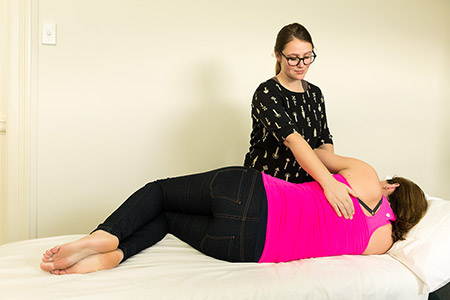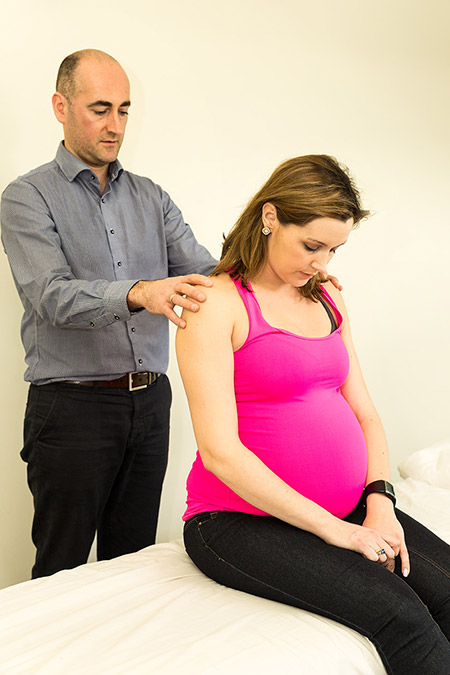Osteopathy is an holistic and practical therapy of manual medicine, which focuses on restoring and maintaining optimal health. This whole body system of treatment is based on unique biomechanical principles that are applied to the structure and function of mechanical conditions within the body.
Osteopaths are highly skilled at identifying and diagnosing dysfunction or alterations within the musculoskeletal system. These problems may alter the circulation of blood or lymphatic drainage, and disrupt the nerve supply to any part of the body, consequently causing a negative effect on health.
Osteopathy recognises that the body is one functional unit with each part being dependent upon other parts; therefore, one region may influence or be influenced by another region. For this reason, Osteopaths observe that symptoms (e.g. pain, stiffness and inflammation) in one area may be caused by dysfunction in another area, and aim to identify the primary cause, rather than treat the symptoms at a seemingly unrelated location. This philosophy is applied to consider the whole person for the prevention, diagnosis, and treatment of injuries and illness using manual and physical therapies.
Osteopaths use a wide range of "hands on" techniques to treat musculoskeletal and other functional problems in order to restore the body's structure and function to a state of balance. These techniques are gentle and considered very safe. Treatment works in a subtle manner with the body's structure to enhance and accelerate the healing process.
As Osteopaths treat the whole person you may be offered personal advice on stretching and strengthening exercises, posture, diet, lifting procedures, ergonomic assessment and stress management.
The World Health Organisation (WHO) recognises the Osteopathic concept of somatic dysfunction as being scientifically proven, and the British Medical Association recognises Osteopathy as a discrete medical discipline.

Cranial osteopathy (also known as craniosacral, cranial, involuntary mechanism (IVM), osteopathy in the cranial field) is a subtle osteopathic treatment technique that augments the release of tension and strains throughout the body, including the head.
Cranial osteopathy is a gentle and light, yet powerful and extremely effective approach for the treatment of symptoms of a wide array of conditions. It is suitable for people of all ages, from the new born to the elderly patient.
The concept of cranial osteopathy originates from the principles developed by the American osteopath Dr. William G. Sutherland as an extension to the osteopathic approach.
When Dr. Sutherland introduced the cranial concept, he drew on his many years of studying the anatomy of the skull, brain, spinal cord, meninges (membrane covering of the brain and spinal cord), and the sacrum, combined with clinical practice, to base it on fundamental physiological principles. He observed 5 basic phenomena at work in the human body. He called these the Five Phenomena of the Primary Respiratory Mechanism:
The primary respiratory mechanism is in constant, rhythmic and cyclical motion. The movement of the brain and spinal cord, cerebrospinal fluid, meninges, and cranial bones are all synchronous with each other forming one large integrated unit of function.
Dr. Sutherland reasoned that the joints between the bones of the skull were intricately fashioned for the maintenance of motion and that the skull has normal mobility during health and displays restriction in response to trauma or systemic disease. Dr. Sutherland found that when this mechanism, the driving force behind the body's metabolism, anatomy and physiology, is disturbed, the body's ability to self-heal and repair is diminished.
Cranial osteopathy requires a finely tuned palpatory sense to perceive inherent mobility within the craniosacral mechanism and the ability to apply manual technique with precision, depth and dexterity. Therefore, the osteopath is trained to detect the very subtle, rhythmical shape change that is present in all body tissues (involuntary motion, cranial rhythm).
A difficult or traumatic birth, an impact of the head or tension in the body may impede or disrupt the cranial rhythm. This can lead to a variety of problems in the head or other regions of the body. By observing the patient's involuntary motion through the tissues, osteopaths can determine what your cranial rhythm is doing and whether you are in an optimum state of health, or whether something is preventing ideal and healthy movement of the tissues. This identifies the stresses and strains your body is subjected to at present and what pattern of tension it may be carrying as a result of its past history. It also provides the osteopath an insight into the overall condition of your body, whether it is healthy, stressed or fatigued.
When we experience physical or emotional stresses our body tissues tend to tighten up. The body may be able to adapt to these effects at the time, but a lasting strain often remains. Any tensions which remain may restrict the body's free movement. Gradually over time, the body may find it progressively difficult to cope with accumulated stresses and symptoms may develop. If the bones of the skull or the underlying membranes (meninges) lose their flexibility or ability to function normally in a relaxed fashion, you will be unable to relax (i.e. disruption to sleep patterns). Mobilisation of the cranial bones assists the release of subtle tension and stresses in the deeper structures enabling the body to return to a state of balance and well being.
While being extremely effective for relieving symptoms, cranial osteopathy aims to treat the whole person, not just the condition, therefore, a myriad of situations or conditions may benefit from treatment.
These include -
The objectives of cranial osteopathy are to improve mobility within articular (joint) restrictions, reduce membranous tension, improve circulation; reduce potential for nerve entrapment at the base of the skull and improve the vitality of the cranial rhythmical impulse. It is viewed that achieving this improves the level of wellness of the patient.
WHAT DOES TREATMENT INVOLVE?
After compiling a detailed case history, the osteopath will instruct you to lie on the treatment table on your back and they will begin by observing your cranial rhythm with their hands at the base of your skull (cranium) or tailbone (sacrum) applying a light, steady pressure. Some patients describe feeling sensations of pressure or warmth, either under the osteopath's hands or elsewhere, or falling into a state of deep relaxation or a floating sensation as the tension is gradually released.

Presence of the pregnant uterus results in repositioning the centre of gravity in the body upward and forward, especially in late pregnancy. Postural changes in pregnancy include forward tilting of the pelvis with a resulting increase in the lordotic (backward arching) curves in the cervical and lumbar area of the vertebral column, rounding of the shoulders, and hyperextension of the knees. These adaptations are caused partly by the combination of weight gain and an increase in weight distribution in the breasts and abdomen.
As the pregnancy continues to develop, enlargement of the abdomen further reduces the potential for muscles to counterbalance. This is a living example of the physiological principle of the length-tension relationship in which muscles can be stretched beyond their capacity to contract efficiently. The muscles along the spine shorten and are unbalanced by the overstretching abdominal muscles at the front.
The biomechanical effects of pregnancy on the chest wall are apparent during the second half of the pregnancy especially during the last trimester. Progressive uterine enlargement repositions the diaphragm upwards which results in increased chest circumference, altering lung function.
There is also a softening of the ligamentous and connective tissue especially in the pelvis, caused by the production of the hormone, relaxin and other pregnancy hormones. This increases mobility which produces a form of pelvic instability, so the pregnant woman tends to walk with a waddling gait. Ligament softening also produces an increase in pelvic diameter, which is of benefit during labour. However, these changes predispose the pregnant woman to strains in the supporting structures.
During natural delivery, the sacrum (tailbone) flexes forward to assist delivery, by widening the pelvic outlet. The hip, pelvis and abdominal musculature undergo maximal physical stress, with resulting strain on the back and the pelvic and sacroiliac ligaments. The patient's position and the stress involved, when added to the laxity of the ligaments at delivery, can create pelvic joint dysfunctions. These dysfunctions may worsen and contribute to pelvic asymmetry as the ligaments regain their normal tensile strength following childbirth.
Pregnancy increases susceptibility to musculoskeletal injuries especially lower back pain, which is one of the most common complaints of pregnancy. The mechanism of lower back pain in pregnant women relates to change in centre of gravity associated with forward tilting of the pelvis, the increase in lumbar lordosis and ligament loosening. The incidence of lower back pain may be reduced by improving posture and avoiding sudden movements as well as strengthening the abdominal and back muscles.
Other Pregnancy Related Complaints May Include:
An important consideration for the preparation for childbirth is ensuring that the mother's pelvis is structurally balanced and capable of allowing easy passage of the baby along the birth canal. Following childbirth the body has to recover from the changes that occurred during pregnancy and the effects of labour and delivery. Caring for a newborn can place significant demands on the back, such as nursing in poor positions, manoeuvring car seats, reaching into cots and carrying children etc.
Your osteopath may advise on posture, prescribe pelvic floor and post-pregnancy exercises and demonstrate some self-help techniques for the mother and her partner to do during labour.
Seemingly minor problems, especially those involving the back may be the beginning of a lifetime of musculoskeletal difficulties. Childbearing women without other clear traumatic or visceral causes of back pain can often trace part of their own history to a difficult labour and/or post-pregnancy onset. Consequently, unresolved childbirth stresses in the mother may contribute to ongoing back problems, period dysfunction, stress incontinence, constipation, headaches and more. Therefore, osteopathy due to its gentle nature is the perfect option for care before, during and after pregnancy.